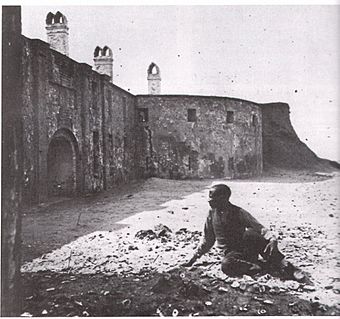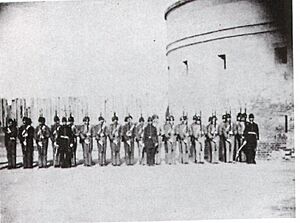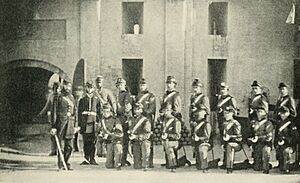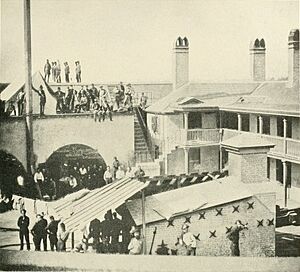Castle Pinckney facts for kids
Quick facts for kids |
|
|
Castle Pinckney
|
|

View of Castle Pinckney, 1861
|
|
| Nearest city | Charleston, South Carolina |
|---|---|
| Built | 1808 |
| NRHP reference No. | 70000574 |
| Added to NRHP | July 16, 1970 |
Castle Pinckney was a small fort built in 1810 by the United States government. It was located in the harbor of Charleston, South Carolina. During the American Civil War, it was briefly used as a prisoner-of-war camp and a place for artillery (cannons). In 1970, it was added to the National Register of Historic Places.
Contents
History of Castle Pinckney
Building the First Fort
Castle Pinckney was built on a small island called Shutes Folly. This island is about one mile from the Charleston shore. The fort was built on top of an older fort's ruins. That first fort was called "Fort Pinckney."
Building Fort Pinckney started in 1797. It was named after Charles Cotesworth Pinckney, a hero from the American Revolution. The fort was meant to protect Charleston from possible naval attacks. At that time, war with France seemed likely. The first fort was finished in 1804. It never saw any fighting. A very bad hurricane in September 1804 almost completely destroyed it.
The New Castle Pinckney
A new fort, made of brick and mortar, was built in 1809–1810. This was the "Castle Pinckney" we know. Soldiers were stationed there during the War of 1812. This conflict lasted two and a half years. However, Castle Pinckney did not see any action. After the war, the fort was left empty and started to fall apart.
About 20 years later, a sea wall was finished around the fort. Soldiers returned to the fort in 1832. This was during the Nullification Crisis. During this time, President Andrew Jackson was ready to use military force. He wanted to collect a controversial tax called a tariff. After this short period, the fort was again left unused. It mainly served as a storage place for gunpowder and other military supplies.
By the late 1850s, Castle Pinckney was part of Charleston Harbor's defenses. Other important forts included Fort Sumter and Fort Moultrie. In 1860, Castle Pinckney had many cannons. These included 24-pounders, 42-pounders, howitzers, and mortars. These weapons were there to protect the fort.
Castle Pinckney During the Civil War
Seizure of the Fort
On December 27, 1860, South Carolina left the Union. One week later, the fort was given to the South Carolina militia. Its small U.S. Army group moved to Fort Sumter. They joined Major Robert Anderson there. Castle Pinckney was the first Federal military site. It was taken by force by a Southern state government.
Three days later, the Union's Charleston Arsenal also fell to South Carolina forces. After the Confederate attack on Fort Sumter, the Charleston Zouave Cadets guarded Castle Pinckney.
Prisoners at the Fort
On September 10, 1861, 154 Union Army prisoners arrived in Charleston. They had been captured during the First Battle of Manassas. They were first kept at the Charleston City Jail. Later, the lower rooms of Castle Pinckney were made into cells.
On September 18, prisoners from several New York and Michigan regiments were moved to Castle Pinckney. During the day, they could move around. At night, they were locked in their cells.
However, the Castle was too small for many prisoners. It was not good for long-term confinement. So, on October 31, 1861, the prisoners were moved back to the Charleston City Jail. They had been at the fort for only six weeks. After the prisoners left, the fort was made stronger. It got more mortars and Columbiad cannons. On December 12, the prisoners were moved back to the island. This was because a fire had damaged the jail and a large part of Charleston. They stayed for just over a week. Many slept outside before being moved again.
After the Civil War
Later Use and Decline
After the Civil War, the fort was updated. This was in case it was needed during the Spanish–American War. But again, it was not used. Some people believe the fort never fired a single shot in battle. Parts of the old brick walls were taken down in 1890. This was to make room for a harbor lighthouse. The lighthouse worked into the 20th century.
Some people in the area did not want the lighthouse. They wanted to build a retirement home for soldiers on the island instead. In 1924, Castle Pinckney was made a U.S. National Monument by the President. In 1951, Congress decided to remove its National Monument status. The fort was given back to the U.S. Army Corps of Engineers. In March 1956, the island became extra property. This meant the government could sell it.
Attempts at Preservation
In 1958, the State Ports Commission bought the island for $12,000. They planned to use it for dumping material. They also thought about making it a historic place for visitors. But using the island for dumping did not work well. No good plans for tourism were made either. The Commission tried to give the island back to the Federal government. But the government said no. They felt the cost of keeping it up was more than its historical value.
The Commission received offers to buy the island. People wanted to use it as a private home, a nightclub, or a restaurant. But the agency refused all these offers. On December 22, 1967, a fire destroyed an old house on the island. However, a warehouse was saved.
A local group called the Sons of Confederate Veterans took care of the island in the late 1960s. They tried to save it and create a museum. Castle Pinckney was added to the National Register of Historic Places in 1970. But the group could not raise enough money. So, the fort went back to state ownership. Castle Pinckney has had some small restoration work done. It is hard to get to because it is on an isolated sandbar in the middle of the harbor. This makes it very difficult to maintain. Over time, nature is slowly taking it back.
Images for kids








